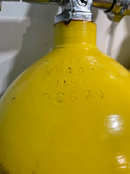I had a scuba shop in Cape Cod Mass take a pair of steel 50s that I dropped off for hydro. He gave me back my valves & other hardware but kept my tanks, saying that it was illegal for him to return them to me. He said that they failed due to having NPT threads & they didn't even need to get pressure tested. He had failed them visually. I was very angry that he took my property & would not return it, but I was young at the time & didn't understand my legal options. I never shopped there again. I doubt that he is still in business. It was a long time ago.
Yes, what he did is totally illegal. He stole your property and he might have destroyed it...
It is hard to know if he was really that ignorant. There is nothing wrong with NPT (tapered) threads. If he had storage cylinder with his air system they would be that style of threads even with new cylinders.
I am fairly certain that they are the most common threads for pressure vessels. Most industrial pressure vessel use tapered threads.




